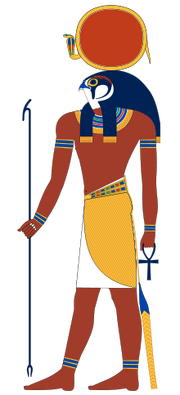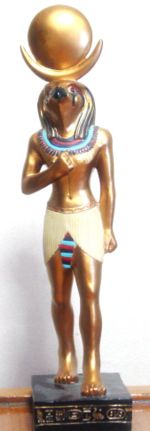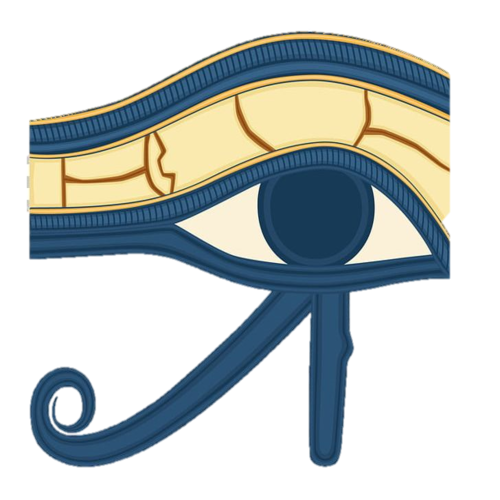Template:God/Goddess
| Ra in Hieroglyphs | |||||||||||
|
Ra (Arabic: رع }})(sometimes spelled Rê based on the attested Coptic name and reconstructed as *Rīʕu (ree-uh-uh) ) is the sun-god of Heliopolis in ancient Egypt. In later Egyptian dynastic times, Ra was subsumed into the god Horus, as Re-Horakhty (and many variant spellings).
The sun is either the symbolic interpretation of Ra, his entire body, or just his eye. The symbols of Ra are the solar symbols of a golden disk or the symbol ⊙ (circle with a point at its centre). He was also associated with the Phoenix, as he rose again each morning in flames. According to E. A. Wallis Budge he was the One god of Egyptian Monotheism, of which all other gods and goddesses were aspects, manifestations, phases, or forms of the god.[2]

Ra depicted with the head of a falcon and a sun disk on his head
Deity status
From the eighth dynasty (ca. 2400 B.C.) onward he was elevated to the status of a national deity, and much later was combined with the Theban god Amun to become Amun-Ra, the foremost deity of the Egyptian pantheon. Amun-Ra was the most powerful god and as he grew and grew he made Egypt something of a theocracy. In later times, when the earth god Atum evolved into a god of the setting sun, Atum became considered an aspect of Ra. Khepri, the less important god who pushed the sun across the sky each day, eventually was also absorbed into Ra, as the centuries wore on, becoming the aspect of Ra that is the rising sun. Also in later times, Ra was associated with Heryshaf.
Amon-Ra's identity with Jupiter was acknowledged by the Greeks and Romans. The Greeks even gave the name Diospolis, City of Zeus, to Thebes. He remained paramount for centuries except for a brief suspension during the time of Akhenaten (1350-1334 BCE) when a monotheistic worship of Aten, the sun disk itself, was imposed on the kingdom of Egypt.
Ra itself, however, was also a monotheistic God. A Hymn to Ra (approx. 1370 BCE) was written to stress the pantheistic nature of Ra to combat encroaching polytheism. In it, several gods and goddesses are described, not as beings in their own right, but certain forms of Ra. For example:
- "Praise be unto thee, O Ra, thou exalted Power, who dost enter into the habitations of Ament, behold [thy] body is Temu.
- "Praise be unto thee, O Ra, thou exalted Power, who dost enter into the hidden palace of Anubis, behold [thy] body is Khepera." [3]
Solar barge

Ra in his solar barge.
{C
In order to pass through Duat (the underworld) each night, was Ma'at, i.e. order, the antithesis of chaos, that guided the course of the boat. At the helm of the boat stood Thoth, representative of the moon, who symbolically stood next to Horus, who, in early egyptian myth, represented the sky, and whose dark eye was the moon. It was Horus who steered the boat.
Many of the other gods travelled in the boat with them, and one of them, possibly with the assistant Mehen (who may instead simply be nothing more than a boardgame), defended the boat from attack by the monster of darkness, who wished to devour Ra. In early mythology, it was Set who was the hero defending the boat, and Apep who was the attacker, but in later myth, after Set became regarded as evil, it was Thoth who defended and Set who was the demon. Temporary failure to protect Ra was said to be the cause of solar eclipses, and mere difficulty in doing so was said to cause bad weather.
Those who take Ra's Sun affiliation metaphorically however, note that in Egypt, God was the life[4] and light[5]. The best way to represent this is with the Sun, which provides life through heating the Earth and providing energy for photosynthesis, as well as provides light for all to see. The Sun is then, not Ra, but an object which can be used metaphorically to help people understand Ra.
Hathor and Ra
Hathor and Ra once argued, and she left Egypt. Ra (or Shu) quickly decided he missed her, but she changed into a lioness that destroyed any man or god that approached. This form is characteristic of the melded Hathor-Sekhmet goddess. Thoth, disguised, eventually succeeded in convincing her to return.
Ra in pop culture

A Ra Statuette
- Thor Heyerdahl, the Norwegian explorer and anthropologist, built the boats Ra and Ra II in order to demonstrate that Ancient Egyptians could have communicated with the Americas or transferred pyramid-building technology. On May 17, 1970 Heyerdahl set sail from Morocco on the papyrus boat Ra II to sail across the Atlantic Ocean to Central America.
- Avant-garde jazz artist Sun Ra got his name from Ra.
- Rock band Utopia lead by Todd Rundgren had a 197 album called RA that includes the song "Communion with the Sun".
- The television show Angel (TV series) featured Ra in one of the episodes of season four, "Long Day's Journey (Angel episode)". In the episode, an apocalyptic demon ritually murders five members, or totems of a mystical order called the Ra-Tet. These members are all linked to an embodiment of the god Ra.
- In the 1994 movie Stargate (film)|Stargate, Ra is the alien ruler of Abydos (Stargate) and serves as the main antagonist.
- Apophis (Apep) appears in the TV show "Stargate SG-1". Ra himself is mentioned numerous times throughout the series, but only appears when SG-1 travels back in time in the 8th season finale Moebius (Stargate SG-1).
- American death metal band Nile featured a song on their In Their Darkened Shrines album entitled "In Their Darkened Shrines III: Destruction Of The Temple Of The Enemies Of Ra". Nile are well-known for focusing totally on Egyptian mythology in their music, artwork and lyrics.
- Ra serves as the most powerful of the three Egyptian God Cards in the Yu-Gi-Oh! franchise. "The Winged Dragon of Ra", as he is known in the American version, is a massive golden dragon that can transform into a giant phoenix as one of its many attacks. The other two God Cards are Osiris (Slifer the Sky Dragon) and the God of Obelisk (Obelisk the Tormentor).
- Ra appears in the game Age of Mythology.
- The Dagger of Amon Ra was the second title in the Laura Bow adventure game series. The events are set in the 1920s and mostly take place in a museum with an Egyptian exhibition.
- Ra is also in Ragnarok Online as the MvP Amon Ra
- NBA player Rasheed Wallace, also known as 'Sheed' or 'Ra', has a large tattoo on his right deltoid depicting Egyptian worship to Ra.
- Ra, while never being directly seen, is shown to be in existence in The Sandman series of comics in issue 20.
Notes
References
- Budge, E. A. Wallis. Egyptian Religion. Kessinger, 1900.
- Collier, Mark and Manley, Bill. How to Read Egyptian Hieroglyphs: Revised Edition. Berkeley: University of California Press, 1998.
- Salaman, Clement, Van Oyen, Dorine, Wharton, William D, and Mahé, Jean-Pierre. The Way of Hermes: New Translations of the Corpus Hermeticum and The Definitions of Hermes Trismegistus to Asclepius. Rochester: Inner Traditions, 1999.
